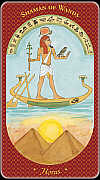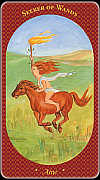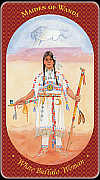Here is an excerpt from The Wise Woman's Tarot companion book, by Flash Silvermoon
When I teach classes on the Tarot, the most common questions come in regard to the use and interpretation of the Court Cards, these cards being the "people cards" of each suit. The traditional Tarot decks refer to these personages as Queens, Kings, Pages and Knights.
For this deck, I chose not to use medieval terms with their hierarchical connotations; so I have radically reworked the "Court Cards" to reflect their higher spiritual values.
I have replaced the Queens with Priestesses, Kings with Shamans, Pages with Maidens and Knights with Seekers.
To best understand the full dimension of these cards in a reading, allow that you or your client could actually be represented by any or all of the court cards. In short, you can discard assumptions like: "shamans always represent men", "priestesses are always female", "the priestess of pentacles is a dark woman", "the maidens are always young and the seekers are always moving."
A more open-ended and psychic approach is required to grasp the essence of these cards. If you are a woman currently working in a place where you have to put 83 business first and ignore your emotions, the Shaman of Pentacles might signify you in a reading even if this is not your typical expression. Likewise, a man, gay or straight, who is doing a lot of emotional work or occupying a pink-collar job may show up as the Priestess of Cups. An older woman who has become a belly dancer in her 75th year and is now the life of the party may see herself as the Maiden of Cups rather than a Priestess. Flexibility regarding sex roles, race, age and ableness are essential to get the most out of these cards.
The Seekers are more action-oriented but not always on an external level. Look to the visual nature of the horse in each card to understand the pace and temperament represented. You will notice that the Seeker of Swords is zealously charging forward while the Seeker of Pentacles slowly and methodically follows her path. The Seeker of Cups makes an offering full of emotion while the Seeker of Wands blazes a trail to freedom.
Allow the subtleties of each deity to permeate your consciousness, and experiment with becoming each of the Court Cards yourself. How do you feel as the Priestess of Swords? By climbing inside these cards, if you will, a much deeper understanding of them and yourself will occur. Of course, the myths associated with each card help, too.
I call this approach ‘Tarot-drama’ and often use it as a learning tool in classes. I may separate out the Court Cards and have everyone pick one of them. After I see who the players are, e.g. Maiden of Pentacles, Priestess of Wands, Shaman of Cups, etc., I devise a general scenario like: We are planning a healing retreat in the mountains for coworkers. Then I ask everyone to do their best to express their card in the context of the scenario with the others in the group. Tarot-drama is a lot of fun and a good way to internalize the learning. It is explained more fully in the subsection, Tarot-drama under the section Tarot Tips.
By using Tarot-drama and other techniques presented in Part III, you will unravel the mystery of the Court Cards and gain access to their wisdom.



